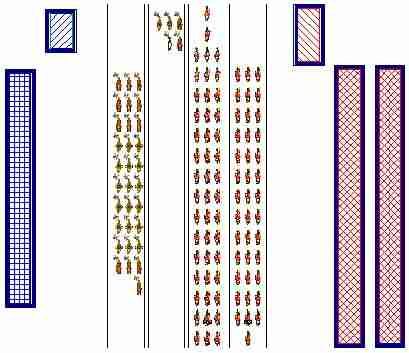Alternative to gaps: The articulated phalanx
Hans Delbrück presents a detailed analysis of the question of gaps in the line. He believes that the description in Livy should be regarded as a drill maneuver used in training but not a combat maneuver. He then argues for an "articulated phalanx." As it evolves over time, the maniples and cohorts gain more autonomy and freedom of movement while preserving the integrity of the battle line.
In the Delbrück reconstruction, all of the various legion formations fought with a solid line broken only by narrow gaps. These gaps served two purposes. First, they provided an avenue of retreat for the skirmishers who otherwise would have had to exit around the ends of the long battle line. This feature is further explored in The Republican Army’s Skirmish Position. The second purposed served was to separate the phalanx into discrete units so that they could maneuver over rough terrain. A long unbroken tightly compacted phalanx would not have been able to march any distance over terrain that had even the slightest irregularity without breaking up and becoming disorganized. Delbrück believes that the Romans broke the phalanx and later legion formations into smaller units precisely for this reason.
He says that, in both the phalanx and the legion formations, the small gaps between the units were naturally closed by the press of men as battle began. During the course of battle, any gaps which opened due to maneuver or causalities were filled in by the units of the second and third lines.
In later formations, Eschelon tactics gave the supporting lines greater freedom and mobility; and later yet, the tactics of the cohort created small tactical units which operated with even more independence.
Duration on the line
A difficulty with Delbrück’s theory is the question of reinforcement and replacement. It is clear that soldiers could be replaced in the line; it is not clear how was this done. Caesar, at Ilerda, notes that he had to send fresh cohorts to the front to replace exhausted soldiers. But the battle he is describing is one of long distance missile fire in which the piecemeal replacement of soldiers would be possible. Could soldiers on the front line who were engaged in sword fighting with the enemy be replaced?
Ancient battles could be long affairs, lasting hours. The victors typically reported few casualties, most deaths seem to have occurred during retreats, routs or due to encirclement. One might conclude that replacements were not necessary until the tide of battle turned, at which time replacements would be too late.
On the other hand, people who have experienced hand-to-hand combat note that it is exhausting. We have several modern parallels in boxing and fencing. 12 rounds of boxing with regular sit-down rests is as much as the best trained modern athlete can do. Fencers experience great fatigue in even short matches. Re-enactors who fight mock battles report exhaustion after but a few minutes of combat. How long could the ancient soldier have endured front line conditions?
Were soldiers in the first rank regularly replaced as they tired? If so, how? One author, Judson, suggests a regular and almost constant movement of men. He allots each man but 15 or 20 minutes in the first rank, to be replaced by the man behind, the entire century being replaced after each rank has had its turn. On paper, with neat rows of men, this seems plausible. In actual combat with its press of bodies, noise and turmoil, it does not seem feasible.
These questions remain among those still to be answered.
Conclusion
The question of gaps is central to an understanding of the tactics of the legion. It does not seem plausible that the legions of Marius could have gone into battle with broad gaps. Schemes for closing and re-opening the gaps (Alternatives to gaps: Closing and re-opening them) do not seems reasonable. The suggestion of Delbrück that the gaps were narrow initially and closed as soon as combat began leaves the problem of reinforcement by the second and third lines and replacement unanswered. The following sections will address, but not solve, some of these questions.




